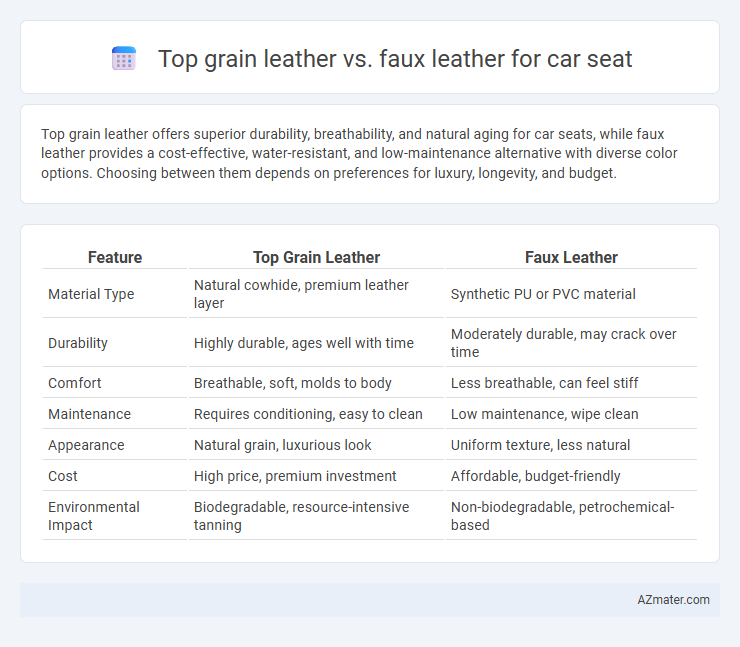Top grain leather offers superior durability, breathability, and natural aging for car seats, while faux leather provides a cost-effective, water-resistant, and low-maintenance alternative with diverse color options. Choosing between them depends on preferences for luxury, longevity, and budget.
Table of Comparison
| Feature | Top Grain Leather | Faux Leather |
|---|---|---|
| Material Type | Natural cowhide, premium leather layer | Synthetic PU or PVC material |
| Durability | Highly durable, ages well with time | Moderately durable, may crack over time |
| Comfort | Breathable, soft, molds to body | Less breathable, can feel stiff |
| Maintenance | Requires conditioning, easy to clean | Low maintenance, wipe clean |
| Appearance | Natural grain, luxurious look | Uniform texture, less natural |
| Cost | High price, premium investment | Affordable, budget-friendly |
| Environmental Impact | Biodegradable, resource-intensive tanning | Non-biodegradable, petrochemical-based |
Overview: Top Grain Leather vs Faux Leather
Top grain leather offers durability, natural breathability, and a luxurious texture ideal for premium car seats, while faux leather provides a cost-effective, water-resistant alternative with easier maintenance. Top grain leather develops a unique patina over time, enhancing its aesthetic appeal, whereas faux leather maintains a consistent appearance but may crack or peel under prolonged use. Choosing between the two depends on prioritizing authenticity and comfort versus affordability and practicality in car seat upholstery.
Material Composition and Production
Top grain leather for car seats is crafted from the upper layer of cowhide, retaining natural grain and durability after sanding and finishing, offering breathability and aging qualities. Faux leather, typically made from polyurethane or polyvinyl chloride (PVC) applied over fabric backing, replicates leather aesthetics through synthetic materials and production processes that prioritize cost-effectiveness and water resistance. The production of top grain leather involves tanning and natural treatment, while faux leather manufacturing relies on chemical and mechanical processes to achieve uniform texture and color.
Appearance and Texture Comparison
Top grain leather offers a natural, rich texture with unique grain patterns and a supple, smooth feel that enhances car seat aesthetics. Faux leather provides a more uniform appearance, often glossy or matte, but lacks the authentic texture and breathability of genuine leather. The tactile experience of top grain leather is softer and warmer, while faux leather can feel synthetic and less breathable over time.
Durability and Lifespan
Top grain leather for car seats offers exceptional durability due to its natural toughness and resistance to wear, often lasting over 10 years with proper care. Faux leather, while more affordable and easier to clean, tends to show signs of cracking and peeling within 2 to 5 years, especially under heavy use and exposure to sunlight. The dense fiber structure of top grain leather enhances its lifespan, making it a superior choice for long-term durability in automotive upholstery.
Comfort and Feel
Top grain leather offers superior breathability and softness, enhancing comfort during long drives by allowing better air circulation and molding to the body's shape. Faux leather, while more affordable and easier to maintain, typically lacks the natural texture and temperature regulation found in top grain leather, which can result in a less comfortable seating experience. The luxurious feel and durability of top grain leather contribute to a premium driving environment, whereas faux leather may feel synthetic and less supple over time.
Maintenance and Cleaning Requirements
Top grain leather car seats require regular conditioning and gentle cleaning with leather-specific products to maintain their natural texture and prevent cracking. Faux leather car seats are easier to clean, often only needing wiping with a damp cloth and mild soap, making them more resistant to stains and spills. Both materials benefit from prompt attention to spills, but top grain leather demands more meticulous upkeep to preserve its durability and appearance.
Environmental Impact and Sustainability
Top grain leather production involves animal agriculture, contributing significantly to greenhouse gas emissions, deforestation, and water consumption, raising concerns about its environmental footprint. Faux leather, often made from polyurethane or PVC, relies on synthetic materials derived from fossil fuels, resulting in plastic pollution and limited biodegradability. Sustainable car seat options prioritize materials with lower carbon footprints, reuse potential, and eco-friendly manufacturing processes, making the choice between top grain and faux leather critical for reducing environmental impact.
Cost and Value for Money
Top grain leather car seats offer superior durability and breathability but come at a higher initial cost, often ranging from $500 to $1,500 or more per set. Faux leather, priced between $150 and $500, provides a budget-friendly alternative with easier maintenance yet tends to wear out faster and lacks the natural aging qualities of top grain leather. Evaluating cost against long-term value, top grain leather delivers better longevity and resale value, while faux leather suits economical choices with moderate use.
Resistance to Wear and Stains
Top grain leather offers superior resistance to wear and stains due to its natural durability and tight grain structure, making it ideal for high-traffic car seats. Faux leather, while more affordable and easier to clean, tends to show scratches and stains more quickly because of its synthetic composition. Choosing top grain leather enhances long-term resilience and maintains aesthetic appeal in automotive upholstery.
Which is Best for Car Seats?
Top grain leather offers superior durability, breathability, and a natural texture that improves with age, making it ideal for car seats requiring long-lasting comfort and luxury. Faux leather provides a more affordable, water-resistant, and low-maintenance alternative, though it lacks the breathability and aging qualities of genuine leather. For car seats, top grain leather is best suited for premium durability and comfort, while faux leather is preferred for budget-conscious owners seeking easy maintenance.

Infographic: Top grain leather vs Faux leather for Car seat
 azmater.com
azmater.com